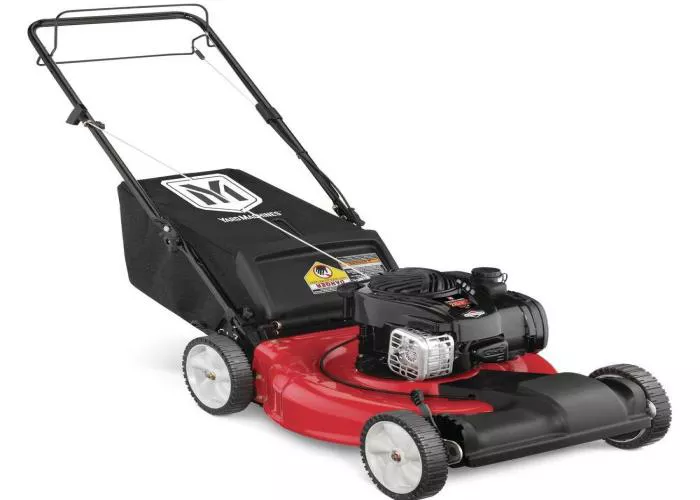An OHV lawn mower is a type of mower equipped with an Overhead Valve (OHV) engine. This design improves efficiency, power, and fuel economy compared to older side-valve engines. OHV engines are commonly found in modern lawn mowers, offering better performance and durability. If you are looking for a reliable mower, understanding OHV technology will help you make an informed decision.
How Does an OHV Engine Work
An OHV engine has valves located in the cylinder head, above the combustion chamber. This setup allows for better airflow and more efficient fuel burning. Here’s how it works:
Air and fuel mixture: The intake valve opens to let air and fuel into the combustion chamber.
Compression and ignition: The piston compresses the mixture, and the spark plug ignites it.
Exhaust release: The exhaust valve opens to let out burnt gases.
This process happens quickly and smoothly, making OHV engines more powerful and fuel-efficient than older designs.
Advantages of OHV Lawn Mowers
OHV lawn mowers offer several benefits over traditional side-valve engines. These advantages make them a popular choice for homeowners and professionals.
Better fuel efficiency: OHV engines burn fuel more completely, reducing waste and saving money on gas.
Increased power: The overhead valve design allows for stronger combustion, giving the mower more cutting power.
Longer engine life: Less heat and friction mean the engine lasts longer with proper maintenance.
Quieter operation: OHV engines run more smoothly, reducing noise levels compared to older models.
Lower emissions: Efficient combustion means fewer harmful emissions, making OHV mowers more environmentally friendly.
OHV vs. Side-Valve Engines
Understanding the difference between OHV and side-valve engines helps explain why OHV mowers are superior.
Valve placement: In OHV engines, valves are in the cylinder head. In side-valve engines, they are beside the cylinder.
Performance: OHV engines provide better airflow, leading to stronger performance. Side-valve engines are less efficient.
Durability: OHV engines experience less wear and tear, making them last longer. Side-valve engines degrade faster due to higher heat and friction.
Maintenance: OHV engines require less frequent maintenance. Side-valve engines need more attention to keep running smoothly.
Types of OHV Lawn Mowers
OHV engines are used in different types of lawn mowers, each suited for specific needs.
Push mowers: Lightweight and easy to maneuver, ideal for small lawns.
Self-propelled mowers: Have a drive system that moves the mower forward, reducing user effort. Great for medium to large yards.
Riding mowers: Best for large properties, offering comfort and power with an OHV engine.
Zero-turn mowers: Provide excellent maneuverability and speed, often equipped with powerful OHV engines for professional use.
Maintenance Tips for OHV Lawn Mowers
Proper maintenance ensures your OHV lawn mower runs efficiently for years. Follow these tips to keep it in top condition.
Regular oil changes: Fresh oil reduces friction and keeps the engine running smoothly. Check the manufacturer’s recommendations for oil type and change intervals.
Air filter cleaning: A clogged air filter restricts airflow, reducing engine performance. Clean or replace the filter as needed.
Spark plug inspection: A faulty spark plug can cause poor ignition. Check and replace it if necessary.
Fuel system care: Use fresh gasoline and consider fuel stabilizers if storing the mower for long periods.
Blade sharpening: Dull blades tear grass instead of cutting it cleanly. Sharpen them regularly for a healthier lawn.
Common Problems with OHV Lawn Mowers
Even the best mowers can face issues. Knowing common problems helps in troubleshooting.
Hard starting: Often caused by old fuel, a dirty air filter, or a bad spark plug.
Loss of power: May result from clogged fuel lines, a dirty carburetor, or low oil levels.
Excessive vibration: Usually due to a bent blade or loose engine components.
Overheating: Can occur from low oil, dirty cooling fins, or running the mower too hard for long periods.
Oil leaks: Check gaskets and seals if you notice oil leaking from the engine.
How to Choose the Right OHV Lawn Mower
Selecting the best OHV mower depends on your lawn size, terrain, and personal preferences.
Lawn size: For small yards, a push mower is sufficient. Larger lawns may need a self-propelled or riding mower.
Terrain: If your yard has slopes or rough patches, a self-propelled or all-wheel-drive mower is best.
Engine power: Higher horsepower (HP) is better for thick grass or tough conditions.
Features: Look for adjustable cutting heights, mulching options, and easy-start mechanisms.
Budget: OHV mowers vary in price. Choose one that fits your needs without overspending.
Environmental Impact of OHV Lawn Mowers
OHV engines are more eco-friendly than older models, but they still have an environmental footprint.
Lower emissions: OHV engines produce fewer pollutants than side-valve engines.
Fuel efficiency: Burning less gas reduces overall environmental impact.
Noise pollution: Though quieter, mowers still contribute to noise pollution. Electric mowers are an even greener alternative.
Proper disposal: Recycling old mowers and engine oil helps reduce environmental harm.
Conclusion
An OHV lawn mower is a powerful, efficient, and durable machine perfect for maintaining a healthy lawn. Its overhead valve design offers better performance, fuel economy, and longevity compared to older engine types. By choosing the right OHV mower and maintaining it properly, you can enjoy a well-kept yard for years. Whether you have a small garden or a large property, an OHV mower is a smart investment for any homeowner.
Understanding how OHV engines work, their benefits, and maintenance needs will help you get the most out of your mower. As technology evolves, OHV mowers will likely become even more efficient, keeping them a top choice for lawn care.
Related topics:
- WHAT IS THE OHV ON A LAWN MOWER?
- WHO MAKES POWERSMART LAWN MOWER ENGINES?
- 5 BEST BUDGET LAWN TRACTORS FOR 2025

